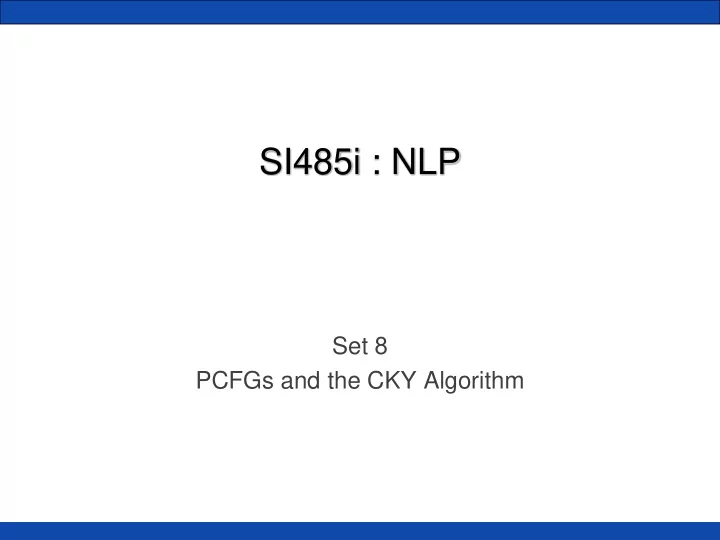

SI485i : NLP Set 8 PCFGs and the CKY Algorithm
PCFGs • We saw how CFGs can model English (sort of) • Probabilistic CFGs put weights on the production rules • NP -> DET NN with probability 0.34 • NP -> NN NN with probability 0.16 2
PCFGs • We still parse sentences and come up with a syntactic derivation tree • But now we can talk about how confident the tree is • P(tree) ! 3
Buffalo Example • What is the probability of this tree? • It’s the product of all the inner trees, e.g., P(S ->NP VP) 4
PCFG Formalized • G = (T, N, S, R, P) • T is set of terminals • N is set of nonterminals • For NLP, we usually distinguish out a set P ⊂ N of preterminals, which always rewrite as terminals • S is the start symbol (one of the nonterminals) • R is rules/productions of the form X → γ, where X is a nonterminal and γ is a sequence of terminals and nonterminals • P(R) gives the probability of each rule. • ∀𝑌 ∈ 𝑂, 𝑄 𝑌 → 𝛿 = 1 𝑌→𝛿𝜗𝑆 • A grammar G generates a language model L. • 𝑄(𝛿) = 1 𝛿𝜗𝑈∗ Some slides adapted from Chris Manning 5
Some notation • w 1n = w 1 … w n = the word sequence from 1 to n • w ab = the subsequence w a … w b • We’ll write P( N i → ζ j ) to mean P( N i → ζ j | N i ) • This is a conditional probability. For instance, the sum of all rules headed by an NP must sum to 1! • We’ll want to calculate the best tree T • max_T P( T ⇒ * w ab ) 6
Trees and Probabilities • P( t ) -- The probability of tree is the product of the probabilities of the rules used to generate it. • P( w 1 n ) -- The probability of the string is the sum of the probabilities of all possible trees that have the string as their yield • P( w 1n ) = Σ j P( w 1n , t j ) where t j is a parse of w 1n • = Σ j P( t j ) 7
Example PCFG 8
9
10
P(tree) computation 11
Time to Parse • Let’s parse!! • Almost ready… • Trees must be in Chomsky Normal Form first. 12
Chomsky Normal Form • All rules are Z -> X Y or Z -> w • Transforming a grammar to CNF does not change its weak generative capacity. • Remove all unary rules and empties • Transform n-ary rules: VP->V NP PP becomes • VP -> V @VP-V and @VP-V -> NP PP • Why do we do this? Parsing is easier now. 13
Converting into CNF 14
The CKY Algorithm • Cocke-Kasami-Younger (CKY) Dynamic Programming Is back! 15
The CKY Algorithm NP->NN NNS 0.13 p = 0.13 x .0023 x .0014 p = 1.87 x 10^-7 NP->NNP NNS 0.056 p = 0.056 x .001 x .0014 p = 7.84 x 10^-8 16
The CKY Algorithm • What is the runtime? O( ?? ) • Note that each cell must check all pairs of children below it. • Binarizing the CFG rules is a must. The complexity explodes if you do not. 17
18
19
20
21
22
Evaluating CKY • How do we know if our parser works? • Count the number of correct labels in your table...the label and the span it dominates • [ label, start, finish ] • Most trees have an error or two! • Count how many spans are correct, wrong, and compute a Precision/Recall ratio. 23
Probabilities? • Where do the probabilities come from? • P( NP -> DT NN ) = ??? • Penn Treebank : a bunch of newspaper articles whose sentences have been manually annotated with full parse trees • P( NP -> DT NN ) = Count( NP -> DT NN ) / Count(NP) 24
Recommend
More recommend